Art World
Is TikTok Trying to Cancel Salvador Dalí? Why Art Historians on the Platform Are Denouncing the ‘Problematic’ Surrealist Icon
'The fact that this guy is still taught as a hero of art is beyond me,' said one TikToker.

'The fact that this guy is still taught as a hero of art is beyond me,' said one TikToker.

Adam Schrader

Art historians are taking to TikTok in a bid to cancel Surrealist icon Salvador Dalí, more than three decades after his death.
Dalí, a Spanish artist known for making bizarre images such as The Persistence of Memory (1931), has long been revered for his contributions to modern art after joining the Surrealists in the late 1920s.
The first such video to appear on TikTok, posted in September 2021 by @That_Art_History_Girl, provided four reasons why Dalí was “problematic.”
“He was fascinated with Hitler. As a child, he pushed his friend from a 15-foot bridge and ate cherries while they were injured,” she said in her video.
@that_art_history_girl what do you guys think of him?#arthistory #arthistorymajor #arthistoryfacts #funfacts #arthistorytiktok #salvadordali ♬ Just The Two of Us – Kauai45 & Sweet Cocoa
Dalí himself confirmed the incident in his 1942 autobiography, The Secret Life of Salvador Dalí, in which he noted that he was a five-year-old child at the time living in a village near Barcelona.
“During the whole afternoon, bloodstained basins were brought down from the room where the child, with a badly injured head, was going to have to remain in bed for a week,” Dalí wrote. “The continual coming and going and the general turmoil into which the house was thrown put me in a delightful hallucinatory mood.”
In her video, @That_Art_History_Girl also noted that Dalí as a kid had kicked his three-year-old sister’s head, saying he thought it was a ball. That was also confirmed by Dalí in his autobiography.
“He committed fraud by flooding the market with his signature. He signed paper that fakers could use to print imitations and make money,” she added.
The TikTok account @SarahDipity1 largely echoed those points in her own video about a year later and dived into greater detail with additional concerns regarding Dalí.
“The fact that this guy is still taught as a hero of art is beyond me. We should start with the bad and work our way into that as a problematic artist,” Sarah said in her video.
@sarahdipity1 Ruining artists for people, who else did you like that can be spoiled for people? #art #artist #fineart #arthistory ♬ original sound – Sarah H
In her video, Sarah added that Dalí “was a sadist, a masochist, and a fascist,” who had once been called a “disgusting human being” by George Orwell in a review of Dalí’s autobiography.
“In his 20s, he actually had a phobia of female genitalia and so he actually was afraid of all women for a long time. And he was also obsessed with himself in the literal sense,” Sarah said. “And so one day, a woman complimented him on the beauty of his feet and so he trampled her and he had to be pulled off of her as she was like bleeding.”
Sarah also pointed to a 1948 photo that emerged from a collaboration between Dalí and the photographer Phillippe Halsman, in which three cats are seen flying through the air as water is thrown on them.
“This photo took 28 takes—which wouldn’t be so bad except for these are three living cats and real buckets of water,” Sarah said. “They essentially tortured these cats for 28 takes until Salvador Dalí was satisfied with the end result.”

Philippe Halsman, Dali Atomicus (1948). Photo: Library of Congress.
Her claim was confirmed by Halsman’s daughter Irene Halsman in an interview with Time in 2016. Irene assisted her father and Dalí as a child by throwing the cats in the air for them to photograph.
“Dalí said, ‘I have an idea. Let’s take a duck and put some dynamite up his derriere and blow him up.’ And my father said, ‘Oh you can’t do that. You’re in America. You might get arrested,’” Irene Halsman recounted of how the idea for the three cats originated.
Sarah, in her video, noted that “worst of all” was Dalí’s “obsession with Hitler.” Dalí made several works in his career about the Nazi leader, including Hitler Masturbating (1973) and The Enigma of Hitler (1939).
“Ironically, Hitler probably wouldn’t have liked him very much because he admitted that he used to imagine Hitler as a woman and that he was turned on by him and that may have been a little too gay for Hitler,” Sarah said in her video.
“Dalí belonged to the artist group of Surrealism who were usually known for their left-leaning views, who actually kicked Dalí out because he was so ferociously fascist.”
In her video, Sarah added: “The next part gets a little spicy. He was also an admitted necrophiliac.” In his autobiography, Dalí dedicated an entire passage to discussing “necrophilic impulses.”
@human_history_on_durgs #historytiktok #notsofunfacts #littleknownfacts #didyouknow #teachinghistory #weirdhistory #crazyhistory #salvadordali #artists #chaos #psychadelic #tripping #badtrip #badideas #edutok #greenscreen #humanhistoryondurgs #stuffyouwontlearninschool ♬ Because I Got High – Extended Version – Afroman
“He was incredibly messed up. His older brother, also named Salvador, died nine months before he was born. His parents convinced him that he was the reincarnation of his dead brother,” the account @human_history_on_durgs added on TikTok. “As a child, he would deliberately throw himself down the stairs.”
Some TikTokers have pushed back on viewers who commented that art should be separated from the artist.
“I’m going to tell you exactly why you cannot. Here’s a little bit of Art Theory 101. When a person makes a piece of artwork, it’s a culmination of their entire life and experience,” TikToker @cloudgorl said in a video.
“I cannot stress this enough. A painting is not just a pretty picture. There are reasons why do things even if we may not know it. Salvador Dalí was a violent, fascist, and sexist man, and that shows in his artwork.”
More Trending Stories:
A Sculpture Depicting King Tut as a Black Man Is Sparking International Outrage